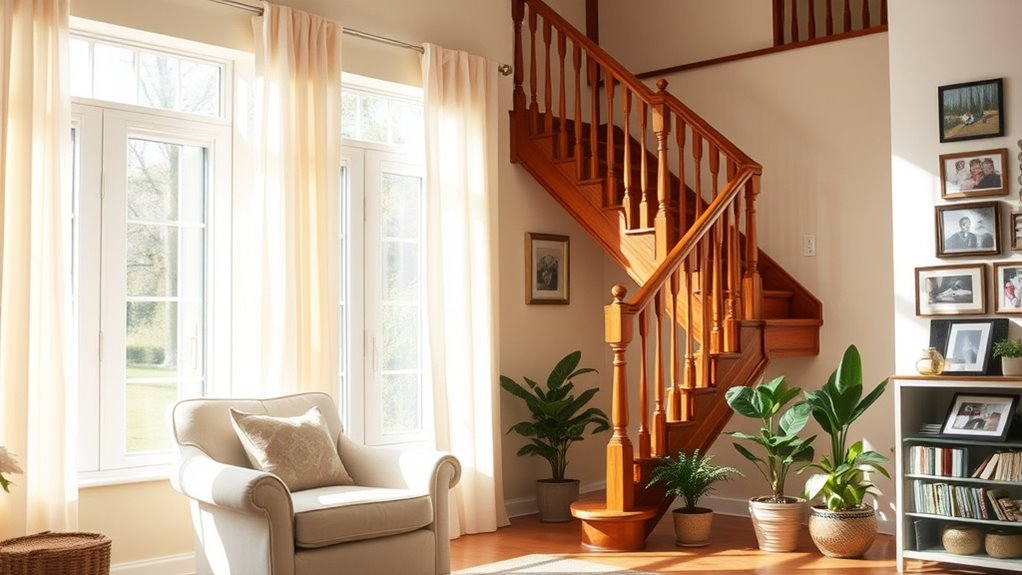Deciding whether to renovate your current home or relocate depends on safety, finances, and your lifestyle. If your home can be updated with safety features like grab bars and better lighting, staying might be best. However, if layout issues or safety hazards are hard to fix, downsizing to a more manageable place could be a better choice. Consider your emotional ties and future needs—exploring options further can help you make the most informed decision.
Key Takeaways
- Assess safety needs and home layout to determine if renovation can address mobility and safety concerns effectively.
- Consider long-term costs and benefits of renovating versus moving, including potential property value increases.
- Evaluate emotional attachment and community ties against safety improvements and lifestyle preferences.
- Factor in financial implications, such as renovation costs, moving expenses, and future affordability.
- Decide based on safety, convenience, financial stability, and emotional readiness to ensure a sustainable aging plan.

Deciding whether to renovate your current home or relocate can be a formidable choice, especially when both options come with their own risks and rewards. When considering staying in your existing residence, one of the main concerns is home safety. As you age, certain features in your home might no longer be practical or safe—like narrow staircases, slippery floors, or high cabinets. Renovating allows you to create a space tailored to your needs, incorporating safety features such as grab bars, walk-in showers, or improved lighting. This not only enhances your comfort but also reduces the risk of accidents, helping you age in place with confidence.
Renovating for safety helps you age comfortably and reduces accident risks at home.
Financial planning plays a significant role in this decision. Renovations can be costly upfront, but they often prove more economical than moving, especially when you factor in moving expenses, real estate commissions, and the potential for higher property taxes in a new area. By investing in your current home, you might increase its value and prolong its usability, which can be beneficial if you decide to sell later. However, you need to evaluate whether the renovation costs fit within your budget and whether the improvements will truly meet your long-term needs. Additionally, considering the home safety features that can be incorporated during renovation can make a substantial difference in your quality of life.
On the other hand, relocating might seem tempting if your current home no longer suits your lifestyle or if safety concerns are too significant to address through renovation. Moving to a smaller, more manageable space can reduce maintenance and adapt to your changing physical needs. Plus, relocating to a community with amenities like nearby healthcare, social activities, and transportation options can greatly improve your quality of life. Still, this option involves careful financial planning. You’ll need to consider the costs of selling your current home, purchasing or renting a new one, and adjusting to a different neighborhood. Sometimes, the emotional toll of leaving a familiar environment can also factor into your decision.
Ultimately, weighing the benefits of home safety improvements against the convenience and social opportunities of moving is essential. Think about your financial situation, future health prospects, and emotional attachment to your current home. If your home can be modified affordably to guarantee safety and comfort, staying might be your best bet. But if the current layout limits your independence or safety concerns outweigh renovation costs, relocating could offer a fresh start in a new environment. Remember, this decision isn’t just about bricks and mortar; it’s about your well-being, financial security, and lifestyle preferences. Carefully analyze your needs now and in the future to choose the option that best supports your goal of aging comfortably and safely.
In addition, exploring unique and creative planters could inspire you to make your living space more inviting and personalized, which can positively impact your overall well-being during this transition.
Frequently Asked Questions
How Do I Assess My Long-Term Financial Stability for Aging in Place?
To assess your long-term financial stability for aging in place, start with solid financial planning. Review your income, savings, and expenses to guarantee you can cover future needs. Incorporate investment strategies that balance growth and safety, adapting as your situation evolves. Consider potential healthcare costs and home modifications. Regularly update your plan to stay on track, giving you confidence to age in place comfortably and securely.
What Community Resources Are Available for Seniors Choosing to Stay?
You can find community resources that boost your well-being, foster social engagement, and enhance your independence. Local senior centers offer activities and support groups, while transportation services help you stay connected. Many communities provide health clinics and home care programs, too. By tapping into these resources, you stay active, engaged, and supported, making aging in place a fulfilling experience. Prioritize these options to build a vibrant, connected life right where you are.
How Can I Ensure My Home Is Accessible and Safe for Aging in Place?
To guarantee your home is accessible and safe for aging in place, start by planning essential home modifications like installing grab bars, ramps, and better lighting. Conduct regular safety audits to identify potential hazards, such as loose rugs or clutter. These steps help prevent falls and make daily living easier. You can also consult professionals for personalized advice, creating a comfortable, secure environment that supports your independence.
What Legal Considerations Should I Be Aware of When Downsizing?
When downsizing, you should be aware of legal considerations like updating your estate planning documents to reflect your new property and understanding property disclosures. Make certain you review your will or trust to designate the right beneficiaries, and disclose any known issues about the property to protect yourself legally. These steps help you avoid future disputes and ensure your assets are managed according to your wishes.
How Does Emotional Attachment Influence the Decision to Stay or Move?
Your emotional ties and sentimental value heavily influence whether you stay or move. When you’re attached to your home or neighborhood, it’s harder to part with those memories, even if downsizing might be practical. These feelings can cause hesitation, making it tough to see the move objectively. Recognizing how emotional attachment affects your decision helps you weigh the benefits of staying versus relocating more clearly.
Conclusion
So, whether you choose to renovate and keep your cherished home or relocate to something more manageable, remember that either choice might just bring its own set of surprises. Sometimes, the comfort of familiarity can feel like a trap, and a fresh start might uncover unexpected challenges. Ironically, in trying to preserve your independence, you might find yourself entangled in a new kind of complexity—proving that aging in place isn’t always as simple as it seems.









